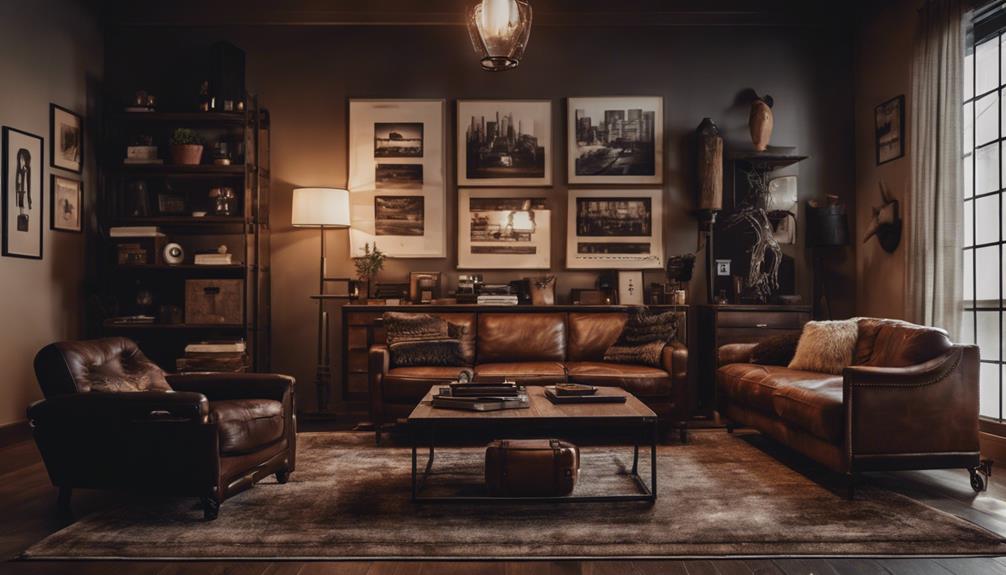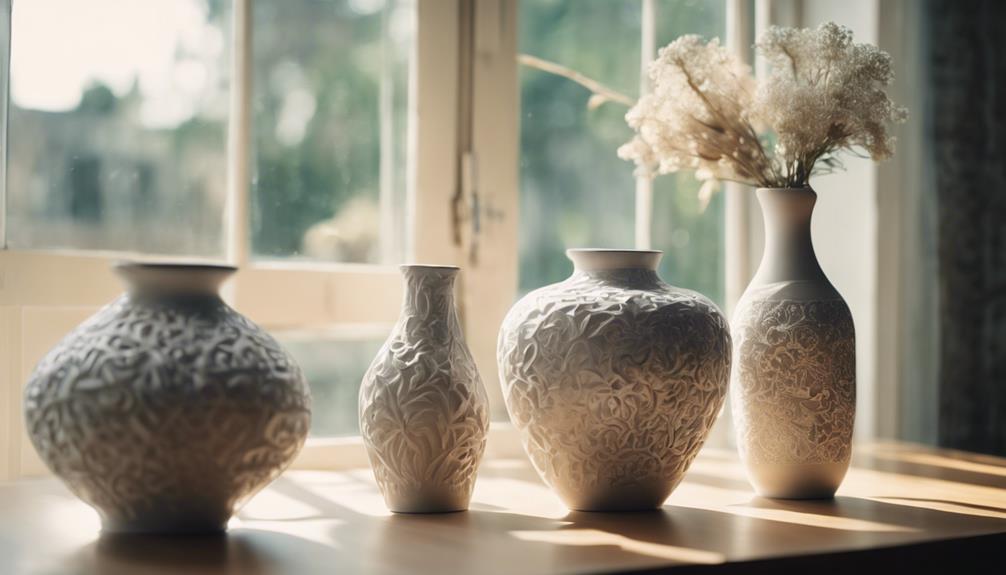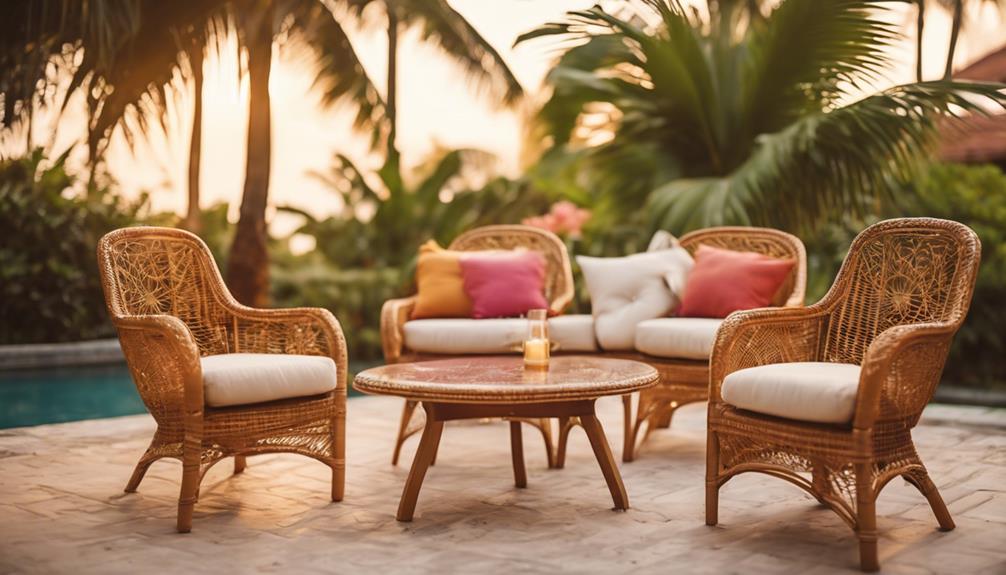To create a masculine room decor that impresses, focus on bold colors like navy or charcoal, and incorporate rugged materials such as leather, wood, and metal. Think about an industrial-style coffee table and comfy leather recliner for essentials. Layer various textures with textured rugs and throw pillows to soften the space. Lighting plays a key role, so consider industrial pendant lights or sculptural floor lamps for ambiance. Don't forget striking decorative elements like metal sculptures and black-and-white photography that showcase your personality. Keep exploring these stylish ideas to guarantee your space stands out!
Key Elements
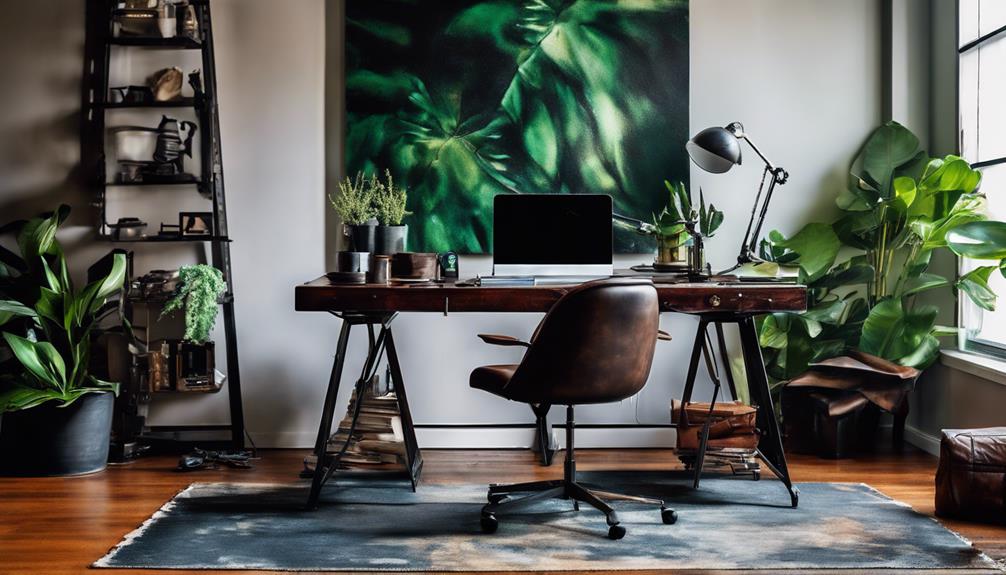
When designing a masculine space, the right color scheme, materials, and textures play a vital role in setting the tone.
You'll want to focus on dark, bold hues paired with rugged materials like wood and metal to create a strong foundation.
Incorporating varied textures can also add depth and interest, making the room feel both welcoming and sophisticated.
Color Scheme
A masculine color scheme typically embraces dark hues like navy, charcoal, and black, creating a robust and sophisticated atmosphere. These colors not only provide a strong foundation for your masculine design but also evoke a sense of strength and elegance.
To add warmth and depth, consider integrating earthy tones like browns and greens. This combination softens the overall look while maintaining a masculine edge.
Monochromatic schemes work wonders in establishing a cohesive feel throughout your space. You can layer different shades of grey, pairing them with white accents to introduce visual interest and balance. Dark accent walls can serve as dramatic focal points, elevating the room's impact and drawing attention to key features.
Don't forget about metallic accents! Incorporating brass or chrome elements can provide striking contrast and add a touch of sophistication to your overall color scheme.
Whether it's in light fixtures, furniture, or decorative accents, these metallics will enhance your masculine design beautifully. By carefully selecting your colors, you'll create a space that's not only stylish but also distinctly yours.
Materials
Incorporating natural materials like leather, wood, and metal is essential for crafting a robust and inviting masculine aesthetic in your decor. These elements not only provide durability but also create a warm, earthy foundation for your space. Opt for rich, dark woods for furniture and accents to enhance the monochromatic color schemes you've chosen, such as navy, charcoal, or black.
Additionally, consider the interplay of materials in your room. For instance, combining sleek metal fixtures with rugged wooden elements can create a striking contrast that adds depth. This blend of natural materials can easily align with a sophisticated ambiance, allowing your decor to feel cohesive yet dynamic.
Integrating accents of leather, whether through a stylish sofa or decorative pillows, can elevate the overall design and invite comfort. Each piece should reflect the masculine character you're aiming for while maintaining a welcoming atmosphere.
Textures
Textures play an essential role in establishing a masculine atmosphere, bringing depth and interest to your decor. By incorporating a variety of materials like leather, wood, metal, and concrete, you can create a rich texture palette that enhances the overall masculine aesthetic of your room.
Consider using natural fabrics such as linen or cotton in throw pillows and bedding. This adds a soft contrast to the harder surfaces, striking a balance between rugged elements and comfort.
Textured rugs made from jute or wool can define spaces and infuse warmth into your decor, making the room feel more inviting while maintaining that masculine vibe. Don't forget about accent pieces; metal sculptures or wooden decor can introduce visual interest and depth, making your space more dynamic and engaging.
When it comes to finishes, opt for varied textures like matte versus glossy surfaces to enhance visual appeal. This creates layers and complexity in the design, elevating the overall look of your masculine space.
Essential Fixtures and Furniture
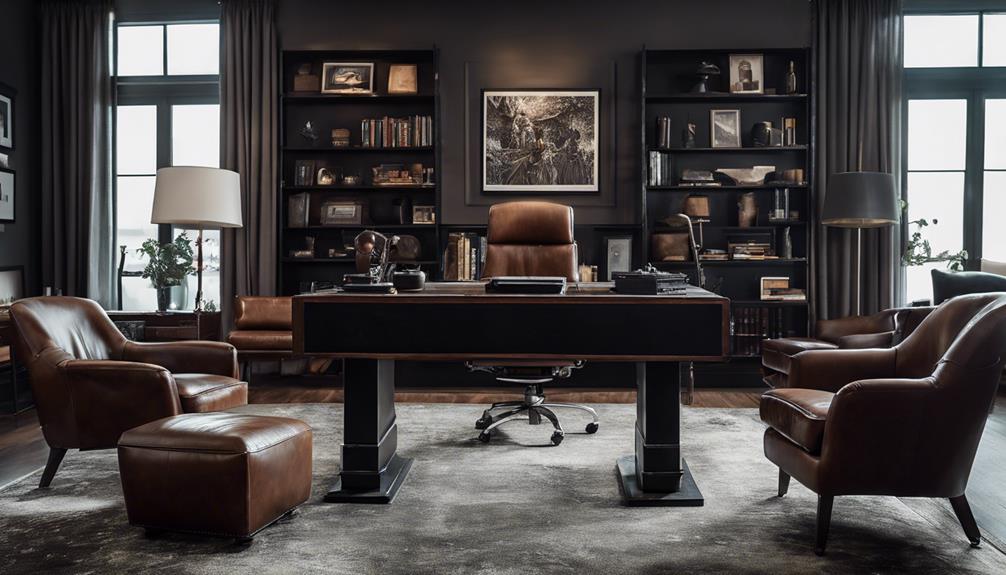
When it comes to essential fixtures and furniture, you'll want pieces that embody strength and style.
Consider an industrial-style coffee table as a bold centerpiece, paired with a leather recliner chair for comfort.
Don't forget a vintage leather ottoman to add character and functionality to your space.
Industrial-Style Coffee Table
An industrial-style coffee table brings a rugged charm to your living space, combining raw materials like reclaimed wood and metal for a striking masculine aesthetic. These tables aren't just functional; they serve as stylish focal points that enhance your masculine interior design. You'll notice that many feature geometric shapes and clean lines, making them versatile enough to fit various decor styles while still standing out.
Consider design ideas that incorporate dark finishes and distressed textures, which create visual interest and align perfectly with a masculine color palette. Some industrial coffee tables even come with storage compartments or shelving, blending practicality with style. This added functionality allows you to keep your space organized without compromising on the rugged appeal.
When you choose an industrial-style coffee table, you elevate your living room's overall design, creating a space that reflects your personal style and sophistication. Opt for one that resonates with your taste, and watch how it transforms your environment into a manly haven, impressing everyone who enters.
Leather Recliner Chair
Pairing perfectly with an industrial-style coffee table, a leather recliner chair adds both comfort and style to your masculine living space. This essential fixture combines a robust aesthetic with rich texture, making it a standout piece.
You'll find that leather recliners are available in various designs, featuring sturdy frames and high-quality leather upholstery. This durability not only enhances the chair's appeal but also guarantees it remains a really nice addition to your decor for years to come.
Many leather recliners come with adjustable reclining mechanisms, allowing you to customize your seating position for peak relaxation and support. The dark leather colors, like deep brown or black, certainly make a bold statement that aligns perfectly with masculine design principles.
To create a cohesive and inviting atmosphere, pair your leather recliner with wooden coffee tables and geometric accent decor. This combination won't only enhance the overall look of your space but also provide a comfortable area for you and your guests to unwind.
Vintage Leather Ottoman
Transform your space with a vintage leather ottoman, a versatile piece that adds both functionality and a touch of timeless elegance to your masculine decor. This ottoman serves as a footrest or extra seating, making it a practical addition. Its rich texture and classic design can elevate the aesthetic of any room, including your dining room, where it might even serve as additional seating for guests.
Crafted from high-quality leather, these ottomans develop a unique patina over time, enhancing their character and depth. Many feature sturdy construction with hardwood frames, ensuring durability and longevity in your stylish manly space. You'll find vintage leather ottomans in various styles, from classic to industrial, which means you can easily incorporate one into your existing decor theme or color palette.
Utilizing a vintage leather ottoman can also serve as a statement piece in your room, enhancing the overall ambiance while reflecting your personal style and sophistication. So, whether you're using it to kick back after a long day or as a decorative accent, a vintage leather ottoman is a must-have for any masculine space.
Lighting Ideas
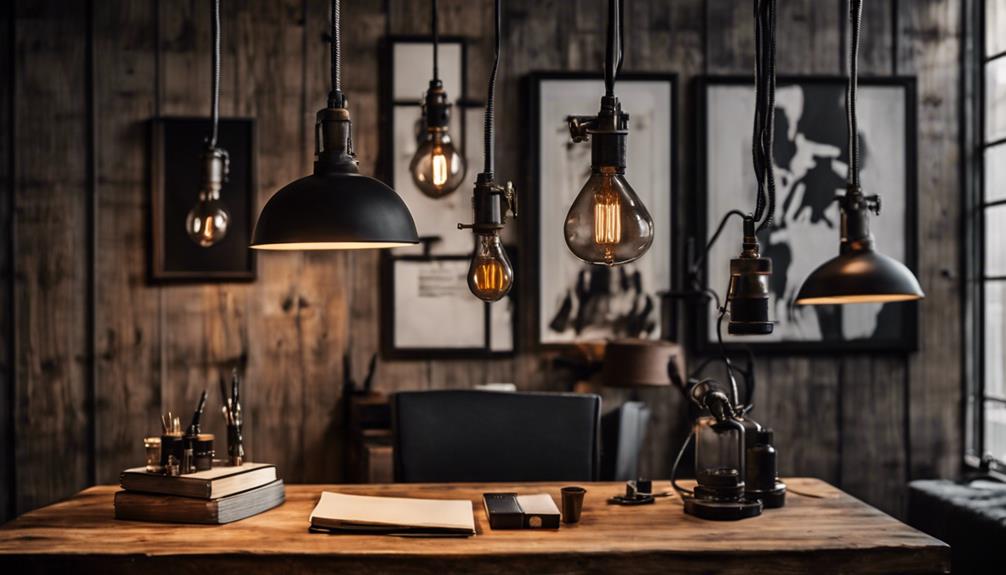
When it comes to lighting, you want to create a bold yet inviting atmosphere in your masculine space.
Consider incorporating industrial pendant lights, sculptural floor lamps, and brushed steel wall sconces for a striking look.
Smart LED track lighting can also add modern functionality, ensuring your room is well-lit and stylish.
Industrial Pendant Lights
Industrial pendant lights, with their rugged designs and exposed bulbs, can make a bold statement in any masculine space. These fixtures often feature materials like metal and glass, adding a touch of raw elegance to your decor. You'll find them in various styles, from vintage to modern, allowing you to choose the perfect match for your room's theme.
One of the great advantages of industrial pendant lights is their adjustable heights, which lets you customize the lighting based on your room size and desired ambiance. If you're aiming for a cozy atmosphere, consider incorporating Edison bulbs; they not only enhance the vintage appeal but also provide warm, inviting light that works beautifully with darker color palettes.
To create a cohesive look, pair these pendant lights with other decorative elements, such as wood and leather furnishings. This combination balances functionality with an aesthetic edge, making your space feel both stylish and comfortable.
Sculptural Floor Lamps
Sculptural floor lamps not only illuminate your space but also serve as striking art pieces that enhance the masculine aesthetic of any room. These functional art pieces provide both light and a bold visual focal point, making them essential for your décor. Look for designs that incorporate rugged materials like metal, wood, or concrete, aligning perfectly with the durable characteristics of masculine decor.
Bold geometric shapes and clean lines resonate with the emphasis on structure and simplicity typical in modern interiors, making sculptural floor lamps ideal for your space. When choosing a lamp, consider adjustable options that provide versatility in lighting. Whether you're reading or creating ambiance for a gathering, these lamps can adapt to your needs while adding artistic flair.
A monochromatic color palette—think black, white, or deep hues—complements a masculine room beautifully. This approach maintains a cohesive and sophisticated look, ensuring that your lighting choices enhance the overall design. By incorporating sculptural floor lamps into your masculine decor, you're not just lighting your space; you're elevating it with style and character.
Brushed Steel Wall Sconces
Brushed steel wall sconces bring a sleek, modern touch to your masculine decor while providing versatile lighting options for any space. These fixtures enhance the sophistication of your room, seamlessly complementing various design themes. Their durability guarantees they'll withstand daily use while maintaining that stylish edge you desire.
You can find brushed steel sconces in a range of styles, from minimalist to industrial, making it easy to fit them into your interior design scheme. Whether you need focused task lighting for a reading nook or ambient light for your living room, these sconces deliver.
Consider pairing them with warm light bulbs to create a cozy atmosphere. This combination balances the coolness of the brushed steel with inviting warmth, perfect for crafting a welcoming space.
Additionally, placing sconces at eye level can highlight artwork or architectural features, further elevating your decor. With their blend of functionality and contemporary design, brushed steel wall sconces are an ideal choice for creating a manly yet stylish environment.
Smart LED Track Lighting
Smart LED track lighting transforms your space with adjustable brightness and customizable color temperatures, creating the perfect atmosphere for any occasion. You can easily switch between warm and cool tones to match your mood or the event, whether it's a cozy gathering or a lively game night.
These lighting systems integrate seamlessly with your smart home devices, allowing you to control them using mobile apps or voice commands. This modern convenience not only enhances your lifestyle but also adds a sleek touch to your masculine decor.
Plus, smart LED track lighting is energy-efficient, helping you save on electricity costs while providing long-lasting illumination.
With various styles and finishes available, you can find options that perfectly complement your design aesthetic, from rugged industrial looks to sleek contemporary vibes. The flexibility of track lighting lets you highlight specific areas in the room, such as artwork or architectural features, creating a dramatic effect that elevates the overall design.
Incorporating smart LED track lighting into your space isn't just practical—it's a stylish choice that impresses everyone who steps inside.
Decorative Elements
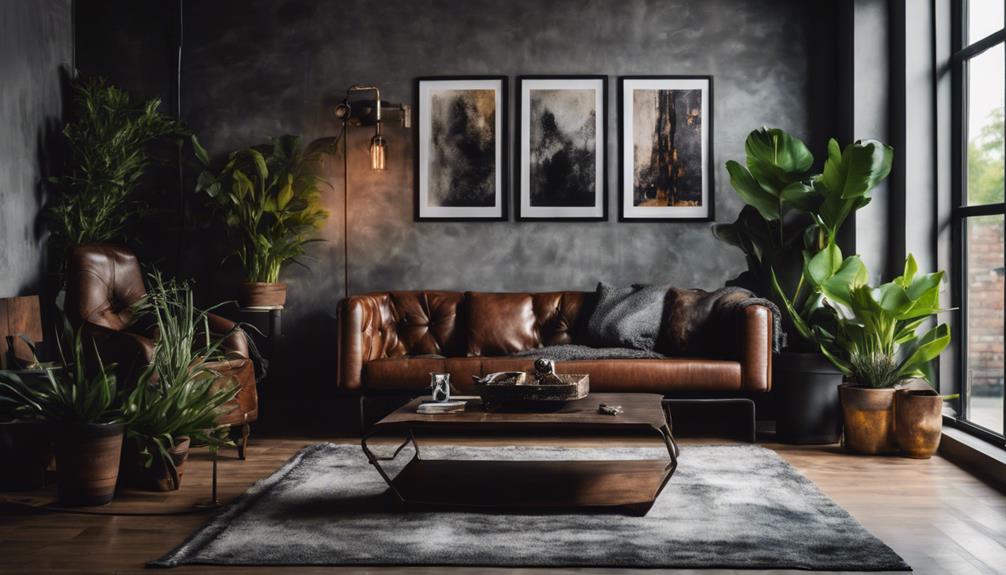
When it comes to decorative elements, you can create a striking atmosphere with framed black and white photography that adds sophistication and drama.
Incorporating a rustic wooden wall clock not only serves a practical function but also enhances the room's character.
Bold metal sculptures can act as eye-catching focal points, reinforcing the masculine vibe you're aiming for.
Framed Black and White Photography
Framed black and white photography instantly elevates masculine decor, adding a sophisticated touch with its striking contrasts and powerful imagery. These timeless pieces enhance your space by creating bold visual statements that draw the eye and evoke emotions.
You'll find that black and white images work seamlessly with various design elements, whether you prefer sleek, modern frames or rustic wooden designs.
Arranging your photographs in a gallery style not only showcases your personal interests but also tells a story, giving your space a unique identity while maintaining a cohesive look. This approach allows you to express individuality without overwhelming the room, making it feel curated and intentional.
Moreover, framed black and white photography pairs beautifully with other masculine design elements, such as industrial materials and rich textures. This combination enhances the overall ambiance of your room, creating a space that feels both inviting and stylish.
Whether you opt for striking landscapes, dynamic street photography, or intimate portraits, incorporating these pieces will certainly impress your guests and elevate your decor to a new level.
Rustic Wooden Wall Clock
A rustic wooden wall clock can effortlessly enhance your masculine decor, combining practicality with the charm of natural materials. This striking piece serves as a focal point, drawing attention while providing functionality for your space.
Using reclaimed wood adds character and a sense of history, ensuring each clock is unique and contributes to your room's rustic theme.
Consider a clock featuring bold, industrial-style numerals. This minimalist design complements masculine elements like leather furniture and metal accents, creating a cohesive look. Depending on its finish, a rustic wooden clock can introduce warm earthy tones, balancing the darker colors often found in masculine spaces.
Opt for a large, statement clock that not only tells time but also acts as a stunning piece of art. A well-placed clock can add visual interest and enhance your room's overall ambiance, making it feel more inviting.
Bold Metal Sculptures
Bold metal sculptures can elevate your masculine decor, adding striking focal points that capture attention and enhance the overall aesthetic of your space. These sculptures often feature geometric shapes or abstract designs that perfectly complement a modern vibe.
When choosing a metal sculpture, opt for materials like stainless steel or wrought iron, which offer both durability and a rugged appeal that fits well within masculine environments. Mixing finishes, such as matte and polished surfaces, can bring depth and visual intrigue to your room while maintaining a cohesive theme.
Large-scale sculptures are particularly effective for filling empty wall spaces, creating a dramatic impact that enriches your room's ambiance. To maximize the aesthetic appeal, position your metal sculptures near natural light sources. This placement allows their textures and reflections to shine, enhancing the overall industrial vibe of your space.
Whether you prefer sleek and minimalistic designs or bold, intricate pieces, incorporating bold metal sculptures into your decor can make a significant statement, showcasing your style and personality while impressing everyone who enters your space.
Flooring
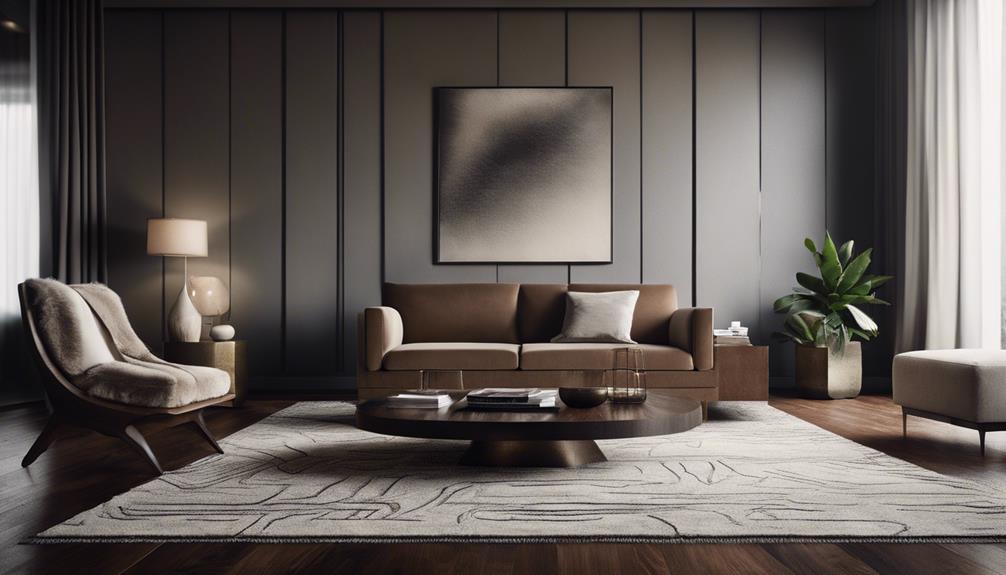
When it comes to flooring in a masculine room, you've got some great options to contemplate.
Dark stained hardwood flooring adds richness and strength, while textured concrete can bring an industrial edge.
To tie it all together, a charcoal gray area rug can soften the look without sacrificing that rugged appeal.
Dark Stained Hardwood Flooring
Enhancing the atmosphere of a masculine space, dark stained hardwood flooring introduces a rich, sophisticated foundation that adds depth and warmth to any room. Choosing dark stains like espresso or walnut elevates the natural grain of the wood, creating a bold contrast that showcases your room's structural elements and furnishings.
This flooring option isn't just about aesthetics; it's also incredibly durable, making it perfect for high-traffic areas. You won't have to worry about everyday wear and tear diminishing its elegant appearance.
Moreover, dark hardwood floors seamlessly pair with various decor styles, from industrial to contemporary, ensuring versatility in your design choices. Whether you're furnishing a cozy den or a sleek office, this flooring can adapt to your vision.
To keep your dark stained hardwood looking its best, regular maintenance is key. Simple tasks like cleaning and refinishing will preserve its beauty and striking presence for years to come.
Ultimately, dark stained hardwood flooring is more than just a base for your masculine space; it's a strong statement that reflects your style while providing lasting durability. Consider it a cornerstone in your quest for the perfect manly decor.
Textured Concrete Flooring
Textured concrete flooring provides a rugged yet stylish foundation for masculine spaces, effortlessly blending durability with modern design. This flooring option isn't only low-maintenance but also offers impressive versatility, allowing you to choose from various finishes like polished, stained, or stamped. You can easily customize it to align with your unique masculine aesthetic.
The natural grey tones of textured concrete seamlessly complement darker color palettes often found in manly interiors. This provides a neutral backdrop that allows bolder decor choices to stand out without overwhelming the space. Additionally, the rugged appeal of textured concrete enhances industrial or contemporary designs while also delivering excellent thermal mass, contributing to energy efficiency.
One of the standout features of textured concrete flooring is its resistance to scratches and stains. This makes it ideal for high-traffic areas or homes with pets, ensuring your flooring remains durable and attractive over time.
Charcoal Gray Area Rug
Adding a charcoal gray area rug to your space creates a rich, neutral foundation that complements the rugged appeal of textured concrete flooring while enhancing the overall masculine aesthetic. This versatile color seamlessly blends with various design styles, from industrial to contemporary, making it a practical choice for any room in your home.
Charcoal gray rugs don't just look good; they also hide dirt and stains effectively, which is perfect for high-traffic areas. You'll appreciate how they maintain a polished appearance even with regular use. Opt for textured options like shag or woven rugs to add depth and warmth, creating an inviting atmosphere that doesn't sacrifice style.
When you pair a charcoal gray area rug with darker furniture or accent pieces, you create a cohesive visual impact that emphasizes the room's bold design elements. This contrast highlights the robustness of your space, making it feel complete and thoughtfully designed.
Conclusion
With these stylish ideas, you can transform your space into a manly retreat that impresses everyone who steps inside.
By focusing on key elements, choosing essential fixtures and furniture, and incorporating the right lighting and decorative touches, you'll create a room that reflects your personality.
Don't forget about the flooring—it can elevate the entire look.
So, roll up your sleeves and start designing a masculine room that's not just functional but also a true reflection of you!
